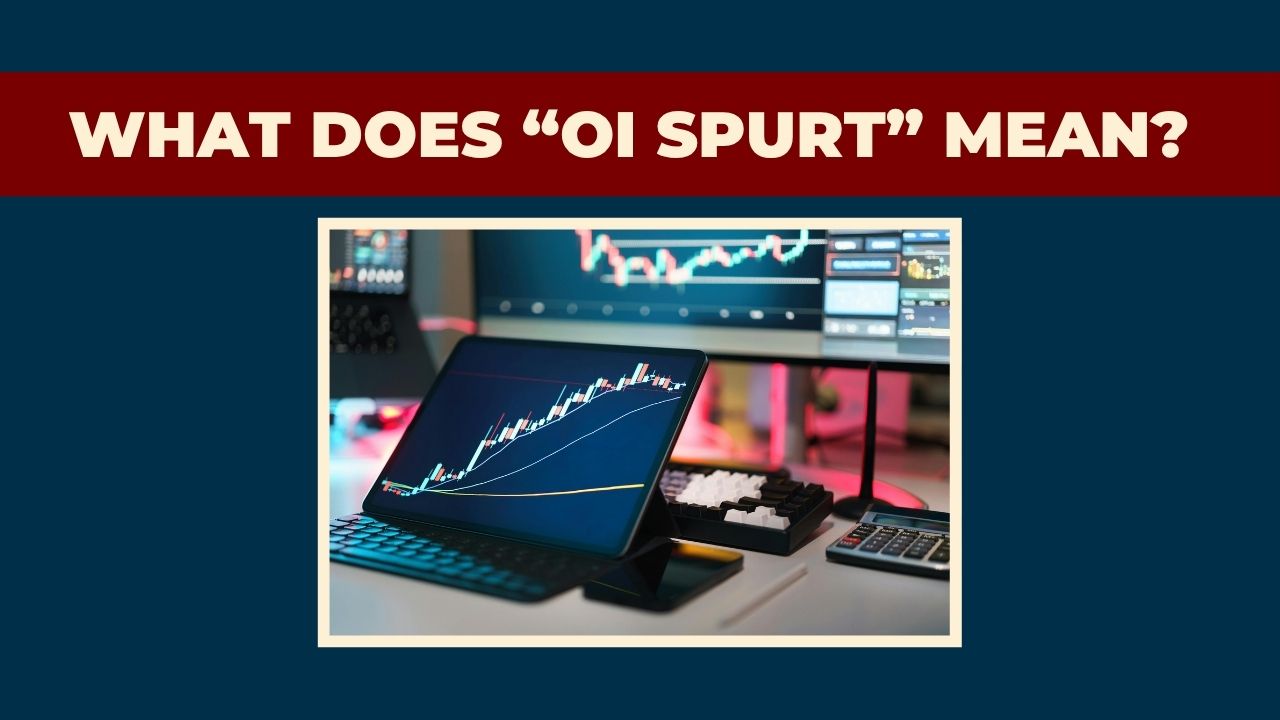If you’re new to trading, the term “OI spurt” might seem like jargon from a complex world. Don’t worry—let’s break it down into simple, digestible pieces so you can understand and use it effectively in your trading journey.
Table of Contents
What “OI Spurts” Means?
The term spurt means a sudden or quick increase.
An “OI spurt” refers to a sudden, sharp increase in Open Interest (OI) for a stock’s futures or options contracts. It’s like a flashing neon sign in the market, signaling that traders are placing aggressive new bets on where a stock’s price is headed next. This surge in activity often hints at potential volatility or significant price movements, making it a key indicator for traders to watch.
Understanding the Key Terms
- Open Interest (OI)
Open Interest (OI) is the total number of active, unsettled futures or options contracts for a stock. These contracts represent “live bets” that traders have placed on the stock’s future price, which haven’t yet been closed, exercised, or expired. When traders open new positions—whether buying or selling a contract—OI increases. When they close their positions (e.g., by offsetting or exercising the contract), OI decreases. In essence, OI shows how many contracts are still “in play” in the market, reflecting the level of trader commitment. - Spurts
A “spurt” is a rapid, explosive increase, like water bursting from a hose or a runner sprinting off the starting line. In trading, an OI spurt occurs when the number of open contracts jumps dramatically—typically by 20% to 50% or more—within a short timeframe, such as a few hours or a single trading day. Unlike gradual increases over weeks, an OI spurt is sudden and significant, grabbing the attention of traders looking for market action.
In short: An OI spurt is a rapid surge in active futures or options contracts, indicating fresh bets on a stock’s future price movement.
Why OI Spurts Matter?
OI spurts act like a market alarm, alerting traders to a wave of new activity. They often suggest that big players—like institutional investors, hedge funds, or large traders—are entering the market with strong conviction, opening substantial new positions. This influx of activity can lead to increased volatility and the potential for significant price swings.
While an OI spurt doesn’t guarantee a price move, it’s a clue that something big might be brewing, especially when paired with other market signals like price trends or news events.
How to Read OI Spurts?
To make sense of an OI spurt, follow these three straightforward steps:
Step 1: Confirm the Spurt
First, verify that the OI increase qualifies as a “spurt.” Look for:
- Magnitude: A sharp rise in OI, typically 20–100% in a single day. For highly liquid stocks, even a 10–20% jump can be notable, while less liquid stocks may need a larger surge (e.g., 50%+) to stand out.
- Timeframe: The increase happens quickly—within hours or a single trading session, not spread over days or weeks.
Step 2: Combine with Price Action
OI alone doesn’t tell you whether the price will go up or down. You need to pair it with the stock’s price movement to understand trader sentiment:
- OI ↑ + Stock Price ↑: Traders are opening new long positions, betting the stock price will rise (bullish sentiment).
- OI ↑ + Stock Price ↓: Traders are opening new short positions, betting the stock price will fall (bearish sentiment).
- OI ↓ (No Spurt): Traders are closing existing positions, which is less significant for predicting future price moves.
Step 3: Add Volume for Confirmation
Trading volume—the total number of shares or contracts traded in a day—helps confirm the strength of an OI spurt:
- High Volume + OI Spurt: Indicates strong new interest and a reliable signal of potential price movement.
- Low Volume + OI Spurt: May be less impactful but can still be significant if driven by major news (e.g., earnings reports, mergers) or in less liquid stocks. Always check for external factors like market events or company announcements to validate the spurt’s importance.
OI Spurts vs. Volume: Don’t Mix Them Up!
It’s easy to confuse OI with trading volume, but they’re distinct:
- Volume: Measures the total number of shares or contracts traded in a day (e.g., 1 million shares traded). Think of it as “how many pizzas were sold at a shop today.”
- Open Interest (OI): Counts the number of contracts still open at the end of the day (e.g., 50,000 unsettled futures or options contracts). It’s like “how many pizza orders are still active and haven’t been delivered or canceled.”
An OI spurt is a sudden spike in these “active orders,” signaling fresh market activity, whereas volume reflects the overall trading frenzy in a day.
Tips for Beginners
OI spurts are powerful, but they’re not a standalone signal. Here’s how to use them wisely:
- Never trade on OI alone. Always cross-check with:
- Price trend: Is the stock rising, falling, or consolidating?
- News and events: Look for catalysts like earnings reports, mergers, sector trends, or macroeconomic events (e.g., RBI policy changes in India).
- Market context: OI spurts during major events (e.g., budget announcements) are more significant than those on quiet days.
- Focus on large-cap stocks like Reliance Industries, Infosys, or HDFC Bank. These stocks have higher trading volume and more reliable OI data compared to smaller, less liquid stocks.
- Start with near-the-money (NTM) or at-the-money (ATM) options, as these typically have higher OI and liquidity, making spurts easier to interpret.
- Use end-of-day OI data for clearer signals. Intraday OI can be noisy and less reliable due to fluctuating activity.
- Leverage free tools to track OI:
- NSE India’s Option Chain: Shows real-time OI for options and futures (nseindia.com).
- Moneycontrol: Offers OI data and market news (moneycontrol.com).
- Trading platforms: Tools like Zerodha’s Kite or Sensibull provide user-friendly OI visuals for Indian markets.
The Bottom Line
An OI spurt is a surge in active futures or options contracts, signaling heightened trader interest and potential for volatility in a stock’s price. For new traders, spotting OI spurts and combining them with price action, trading volume, and news can unlock valuable insights into market sentiment. However, it’s not a magic crystal ball—it’s one tool in your trading toolbox. Pair it with technical analysis (e.g., support/resistance levels) and fundamental research (e.g., company performance) to make informed decisions. With practice, you’ll learn to decode OI spurts and use them to navigate the exciting, fast-paced world of trading.

